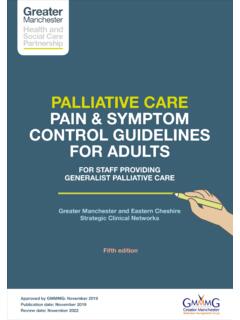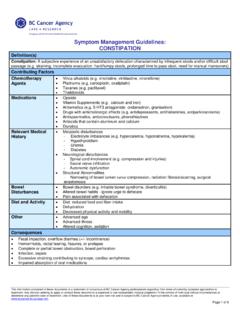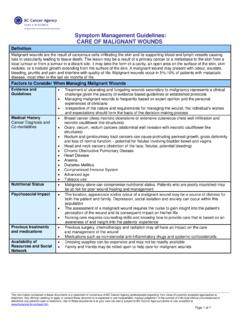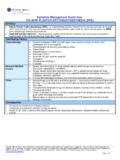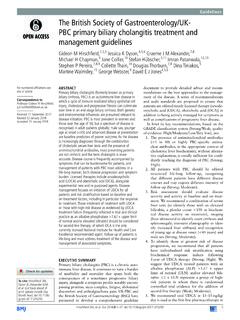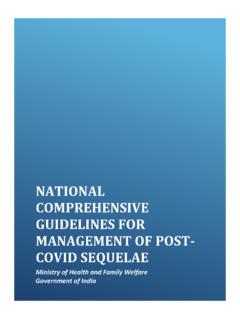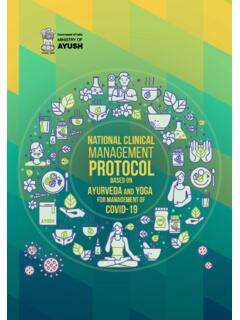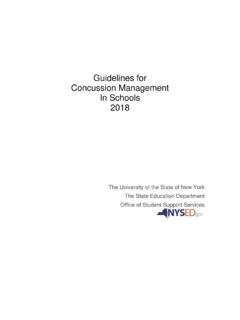Transcription of FY2020 ICD-10-CM Guidelines
1 ICD-10-CM Official Guidelines for Coding and Reporting FY 2020 (October 1, 2019 - September 30, 2020) Narrative changes appear in bold text Items underlined have been moved within the Guidelines since the FY 2019 version Italics are used to indicate revisions to heading changes The Centers for Medicare and Medicaid Services (CMS) and the National Center for Health Statistics (NCHS), two departments within the Federal Government s Department of Health and Human Services (DHHS) provide the following Guidelines for coding and reporting using the International Classification of Diseases, 10th Revision, Clinical Modification ( ICD-10-CM ).
2 These Guidelines should be used as a companion document to the official version of the ICD-10-CM as published on the NCHS website. The ICD-10-CM is a morbidity classification published by the United States for classifying diagnoses and reason for visits in all health care settings. The ICD-10-CM is based on the ICD-10, the statistical classification of disease published by the World Health Organization (WHO). These Guidelines have been approved by the four organizations that make up the Cooperating Parties for the ICD-10-CM : the American Hospital Association (AHA), the American Health Information management Association (AHIMA), CMS, and NCHS.
3 These Guidelines are a set of rules that have been developed to accompany and complement the official conventions and instructions provided within the ICD-10-CM itself. The instructions and conventions of the classification take precedence over Guidelines . These Guidelines are based on the coding and sequencing instructions in the Tabular List and Alphabetic Index of ICD-10-CM , but provide additional instruction. Adherence to these Guidelines when assigning ICD-10-CM diagnosis codes is required under the Health Insurance Portability and Accountability Act (HIPAA).
4 The diagnosis codes (Tabular List and Alphabetic Index) have been adopted under HIPAA for all healthcare settings. A joint effort between the healthcare provider and the coder is essential to achieve complete and accurate documentation, code assignment, and reporting of diagnoses and procedures. These Guidelines have been developed to assist both the healthcare provider and the coder in identifying those diagnoses that are to be reported. The importance of consistent, complete documentation in the medical record cannot be overemphasized.
5 Without such documentation accurate coding cannot be achieved. The entire record should be reviewed to determine the specific reason for the encounter and the conditions treated. The term encounter is used for all settings, including hospital admissions. In the context of these Guidelines , the term provider is used throughout the Guidelines to mean physician or any qualified health care practitioner who is legally accountable for establishing the patient s diagnosis. Only this set of Guidelines , approved by the Cooperating Parties, is official.
6 The Guidelines are organized into sections. Section I includes the structure and conventions of the classification and general Guidelines that apply to the entire classification, and chapter-specific Guidelines that correspond to the chapters as they are arranged in the classification. Section II includes Guidelines for selection of principal diagnosis for non-outpatient settings. Section III includes Guidelines for reporting additional diagnoses in non-outpatient settings. Section IV is for outpatient coding and reporting.
7 It is necessary to review all sections of the Guidelines to fully understand all of the rules and instructions needed to code properly. ICD-10-CM Official Guidelines for Coding and Reporting FY 2020 Page 2 of 121 ICD-10-CM Official Guidelines for Coding and Reporting .. 1 Section I. Conventions, general coding Guidelines and chapter specific Guidelines .. 8 A. Conventions for the ICD-10-CM .. 8 1. The Alphabetic Index and Tabular List .. 8 2. Format and Structure: .. 8 3. Use of codes for reporting purposes .. 8 4. Placeholder character.
8 8 5. 7th Characters .. 9 6. Abbreviations .. 9 a. Alphabetic Index abbreviations .. 9 b. Tabular List abbreviations .. 9 7. Punctuation .. 9 8. Use of and .. 10 9. Other and Unspecified codes .. 10 a. Other codes .. 10 b. Unspecified 10 10. Includes Notes .. 10 11. Inclusion terms .. 10 12. Excludes 10 a. Excludes1 .. 11 b. Excludes2 .. 11 13. Etiology/manifestation convention ( code first , use additional code and in diseases classified elsewhere notes) .. 11 14. And .. 12 15. With .. 12 16. See and See Also .. 13 17. Code also note.
9 13 18. Default codes .. 13 19. Code assignment and Clinical Criteria .. 13 B. General Coding Guidelines .. 13 1. Locating a code in the ICD-10-CM .. 13 2. Level of Detail in Coding .. 14 3. Code or codes from through , .. 14 4. Signs and symptoms .. 14 5. Conditions that are an integral part of a disease process .. 14 6. Conditions that are not an integral part of a disease process .. 14 7. Multiple coding for a single condition .. 15 8. Acute and Chronic Conditions .. 15 9. Combination Code .. 15 10. Sequela (Late Effects) .. 16 11. Impending or Threatened Condition.
10 16 12. Reporting Same Diagnosis Code More than Once .. 16 13. Laterality .. 17 14. Documentation by Clinicians Other than the Patient's Provider .. 17 15. 18 16. Documentation of Complications of Care .. 18 ICD-10-CM Official Guidelines for Coding and Reporting FY 2020 Page 3 of 121 17. Borderline Diagnosis .. 18 18. Use of Sign/Symptom/Unspecified 18 19. Coding for Healthcare Encounters in Hurricane Aftermath .. 19 a. Use of External Cause of Morbidity Codes .. 19 b. Sequencing of External Causes of Morbidity Codes .. 19 c. Other External Causes of Morbidity Code Issues.










